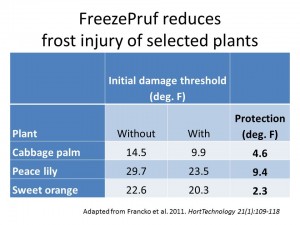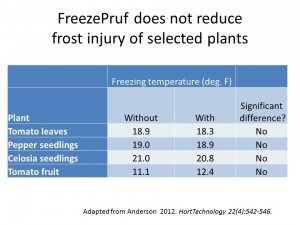I received a comment over the weekend requesting an update on an article I posted back in February of 2010 (Wow, hard to believe we’ve been at it that long!) about FreezePruf, a product that is purported to improve freeze tolerance of garden plants. The ingredients and proposed mode of action of FreezePruf are described in my earlier post, so I won’t repeat them here. Back in 2010, there were no published studies available on the efficacy of FreezePruf; just advertising claims from the manufacturer and data that were included in the patent application.
Since then, there have been two studies published on FreezePruf. One was authored Dr. David Francko at the University of Alabama, who lead the group that developed the product, and the second study was by Dr. Jeff Anderson at Oklahoma State.
Francko et al. (2011) conducted a series of trials, mainly with palms, oranges, and other warm region plants and found that FreezePruf was often highly effective in reducing freeze injury. For example, the figure below suggests that spraying plants with FreezePruf can increase freeze tolerance by 2.3 to 9.4 deg. F. (Note: the authors’ also included two additional palms and two banana cultivars in this portion of the trial; I have simplified their table to show the two extremes and an intermediate response).
Anderson (2012) applied FreezePruf based on label directions and found no change in freezing point depression in peppers, celosia, or tomatoes. Anderson also found that Freezepruf did not improve cold hardiness of Bermudagrass stolons.
So what gives? Is FreezePruf useful or not and why did the studies reach opposite conclusions? Anderson published his paper after Francko et al. but doesn’t offer a clear explanation beyond the use of different plant materials; with the exception of tomatoes, which were included in both trials but still gave different results. One possibility is that the spray may be more effective on perennial plants, especially on older leaves. For instance, in the Francko et al. study they applied FreezePruf to young and old leaves on oranges trees and found a greater and more consistent improvement in cold hardiness on the older leaves than the new leaves. For those of us in the northern U.S., this suggests the product may be of limited use. Typically our greatest concern in protecting plants from freezing is early in season; right after we’ve jumped the gun and planted our annuals and vegetable plugs. Could FreezePruf protect your new petunias from that predicted 25 deg. F night? There is no clear answer in the data so I’ll stick with the tried and true and cover my plants with old bedsheets.
Literature cited:
Anderson, J. 2012. Does FreezePruf Topical Spray Increase Plant Resistance to Freezing Stress? HortTechnology 22(4):542-546.
Francko, D.A., K.G. Wilson, Q.Q.Li, and M.A. Equiza. 2011. Topical Spray to Enhance Plant Resistance to Cold Injury and Mortality. HortTechnology 21(1):109-118.


Thank you for the update.
Any thoughts on whether Freeze-Pruf would protect buds and blossoms of temperate-climate fruit trees — e.g., apples, pears, cherries, peaches, plums, apricots — against late frosts?
Thanks again.
The Francko paper included a test with lemon, rose, azalea, and begonia flowers. In each case there was an improvement in cold hardiness; but the gains were small, ranging from a 2.2 deg. F improvement in rose to a 3.2 deg. F improvement in begonia. Are there times when 2-3 deg. improvement in hardiness would matter? Sure, but it would have to be one of those times when you’re walking the fine line.
In Phoenix, AZ where I reside (USDA 9b) 2 degrees is huge. Frost cloth works pretty well. If a combined spray plus frost cloth would drop that to 4 degrees protection a great deal more could be grown here without too much effort.
Since I cannot see but the abstracts (without being a print subscriber) I cannot evaluate experimental technique. One thing I look for in any comparative study is double blinding. On a single author paper I can assume even a blind study was not possible unless whomever prepared and labelled the test samples and controls was thanked rather than co-authored, so that creates a problem with carrying out the research and evaluating the results (which I can also not evaluate). Indeed the abstracts for this publication are so poor one cannot even get much gist of the results.
Still having tried without noticeable results anti-transpirants with similar claims I am dubious.
Thank you for this update! What can you tell me about the shelf life of FreezePruf? I’ve seen containers of it on sale at a drastically reduced clearance price and am wondering if it’s worth a try or not.
Hi Debbie:
You can check the bottle for an expiration date but according to the MSDS sheet, FreezePruf is stable under recommended storage conditions. The main active ingredient is polyethylene glycol (antifreeze), which isn’t likely to go bad. Certainly no harm in trying. If you do apply some, I’d encourage you to leave a plant or two untreated as a check to convince yourself it actually did something.
I live in CA and I have about 80 cherimoya trees. From what I’ve read, if it goes down to 27 degrees they die. It is rare to go below 30 here or even 32 but every 5 years or so it dips down. I’ve used FreezePruf for the last 4 years. So far, all my cherimoya, avocado, and citrus have survived well. If it even adds 2 or 3 degrees, it is a tree saver. To answer some of the questions here, I bought a bunch 2 years ago and it is good. I put it in a 2-quart jar and shake it well (about 60 seconds) to makes sure it has no sediment. Also, the instructions say to wet the trunk and leaves but not to runoff or it will reduce the effectiveness. I suspect that the age of the plant, the type, and the application are all significant. For what it’s worth, I’m using it again this year even though it is expensive.
Can Freezepruf be utilized to increase the perceived moisture of a plant, or more precisely, of a palm seedling.
Case in point: Growing coconut seedlings in Southern California. They look gorgeous because they just went trhough a very rainy winter. Never froze. But now that we’re getting into spring we are seeing 80F+ days but with very low humidity readings. I mean, non-existent. I was wondering if a plant anti-frost sprayer would help palms react as if they were consistently humid? I hope I make sense.
Thank you
You might try wilt-pruf . Don’t know if its made by the same company . I’ve used it years ago and it worked .
It is the same company and basically the same material. I personally wouldn’t recommend it unless there’s some peer-reviewed research behind it.
I would not do these with palms. Part of their physiology is protecting new leaves with evaporative cooling, which requires open stomata. Sealing off this process guarantees damage.
Stick to sufficient irrigation and mulch well.